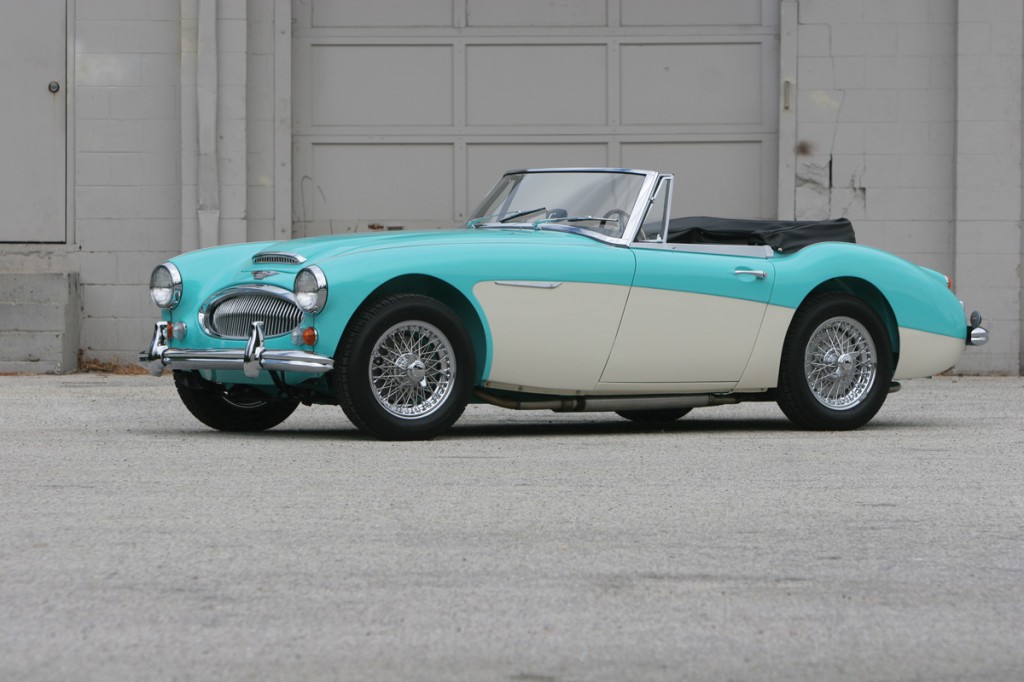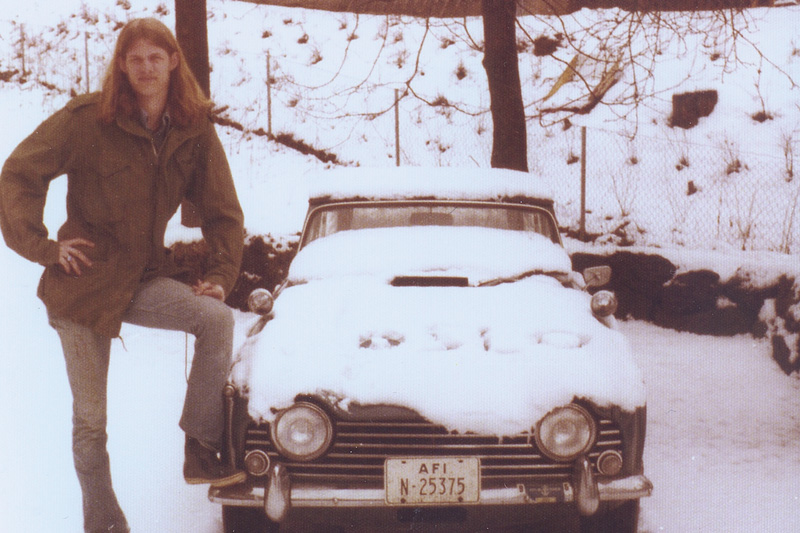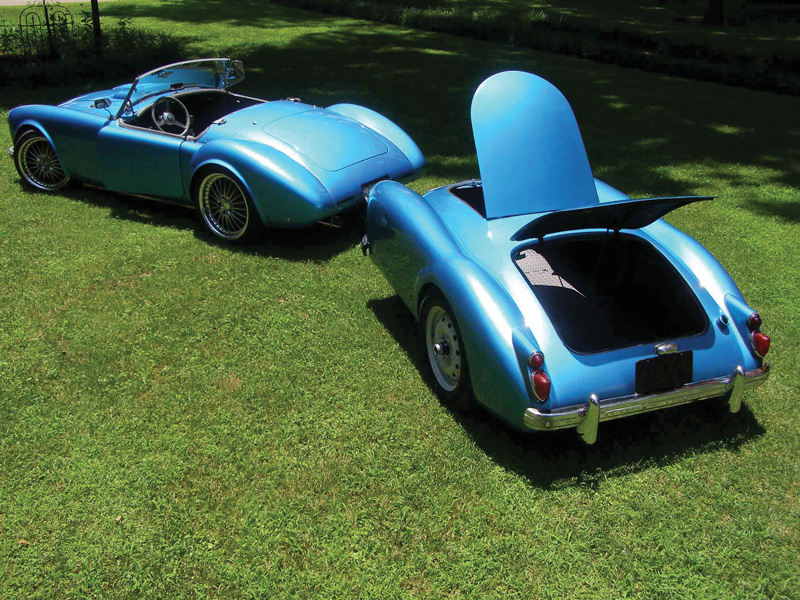The Austin-Healey 3000 was designed by a racing legend, Donald M. Healey, and it embodies everything he wanted in an automobile: gutsy power that could win rallies, a sturdy chassis and mechanicals, and bold, curvaceous styling. For half a century this car has been the object of lust and envy. Top-quality cars have brought six figures at auction in recent years.

Become an educated buyer, spend time behind the wheel, network with club members, and get an inspection before you buy this highly collectible car.
Healey was a bomber pilot in World War I, and afterwards applied his mechanical abilities to cars and racing. He scored the first overall win by a British driver at the 1931 Monte Carlo Rally. He became chief engineer at Triumph and developed the Dolomite roadster.
After World War II, Healey formed his own company with Riley engines powering his first models. Nash mechanicals and Farina bodies were featured on the Nash Healey made from 1950-’54. But this racer yearned for a faster car.
In 1951 Healey started working on the prototype for the Austin-Healey with his son, Geoffrey. He designed the chassis around the Austin A90 2660cc four-cylinder engine, and penned his design concepts, which were formalized by Gerry Coker. When they tested the prototype at Jabbeke Motorway in Belgium, it reached 111 mph, so they called it the Healey Hundred.
The car was a sensation at the 1952 Earl’s Court International Motor Show, and Leonard Lord, chief of BMC/Austin, immediately contracted to build the car, calling it the Austin-Healey 100. It won awards at international car shows, the World’s Fair and a variety of prestigious endurance races, including class wins at Sebring. Plus it broke many stock car land speed records.
The 3000 Evolves From the 100 Six

The family resemblance between the 100 (with windshield folded down) and the later 6-cylinder (with hard top) is clear. The classic good looks will get you a thumbs-up from people you pass, but it is the driving that will put a smile on your face.
After a variety of model changes to the 100, including replacing the four-cylinder engine with a six-cylinder in 1956, a model name change came along in 1959. The Austin-Healey 3000 was little more than a 100 Six with a bigger engine (2912cc) and better front brakes. There were no outward changes other than badges, but the 3000 was 5 mph faster and reached 100 mph five seconds quicker than the 100 Six. Its rating at 124 bhp at 4,600 rpm and 162 lbs-ft of torque at 2,700 rpm set its reputation and further appeal.
The 3000 proved well suited to long-distance rallies, easily cresting the alpine passes. It chalked up 40 overall wins at major rallies under the leadership of Marcus Chambers, head of BMC’s competition department. Pat Moss (Stirling’s sister) scored an overall win in the Leige-Rome-Leige Rally in 1960. It was the only British car to ever win this rally twice.
There were yearly upgrades for the 3000, with more significant changes happening in 1961 with the Mark II model and in 1963 with the Mark III model (see specifics in the sidebar). The changes improved the basic model without changing its character.
BMC’s money troubles forced them to sell to British Leyland in January 1968, and production on the 3000 ceased just two months later. About 90 percent of the 42,917 Austin-Healey 3000s made during the 10 years of production were sold in America.
Drive One First

The six-cylinder engine fits nicely in the long engine compartment; the two-carburetor set-up is easier to keep in tune than the three-carb set-up.
Michael Grant, Product Manager at Moss and longtime Healey enthusiast, owns a BJ8. He had some advice for prospective buyers.
“The experience of driving one may not meet your expectations,” says Grant. The lack of power steering, plus the lack of power brakes on early cars, may make it harder to drive than you’re used to, he explains. Overdrive makes a huge difference on the freeway. He adds that the low-slung look is not just a look—the car sits low and the exhaust system scrapes on what seems like insignificant bumps.
Interior space is also an issue—the roomiest Healey is cramped if you’re tall or large, says Grant. The BJ8 with rollup windows and the nice interior is more cramped than early cars with side curtains. The short doors and small cockpit make it hard for some to get in and out.
If you’re determined to buy one, buy the best car you can afford, advises Grant. “A car that was restored several years ago and has been maintained by someone who cared and knew what they were doing will be a much better buy at $40,000 than a $15,000 project car. A great deal often turns into a four-wheeled money pit,” he says.
While making a purchase, be particularly careful inspecting bodywork for rust, says Grant. Check the front suspension by looking for unusual tire wear, doing a road test, and getting an inspection by a club member or professional. A car that has been in an accident will often have front-end alignment problems, and the front suspension has no camber adjustment to address it. Correcting frame alignment problems can be expensive. Be sure to make the sale dependent on an inspection by a Healey specialist with a good reputation, he adds.
Parts to Enhance Maintenance and Safety
Practical modifications and upgrades can make the cars easier to maintain, and in some cases, safer, says Grant. Spin-on oil filter conversions do a much better job of filtering the oil (Moss recommends a K&N filter) and make it easier to change the oil.
If the car has not been converted to run on unleaded fuel, install hardened valve seats and use Stellite-faced exhaust valves, says Grant. A gear reduction starter weighs less and takes less juice to turn over the engine. Slotted and drilled brake rotors with EBC brake pads improve braking with reduced brake dust. A sealed battery weighs less, takes up less room, and won’t rot the trunk lining.
Brighter headlights are a simple upgrade—Moss offers three types of H4 Halogen lamps, says Grant. Driving lights are a traditional accessory, and Moss has a new badge bar for mounting these as well as club badges.
If the cooling system is stock and seems to run hot, consider having the radiator re-cored if you’ve ruled out the other causes of overheating, suggests Grant. With a thicker radiator core and a Texas Kooler fan you can control the engine temperature.
Healey-Hot-Foot

The 3000 interior has a lovely elliptical instrument panel and finish detail, but can be tight on space and toasty hot.
“Healeys are notorious for being hot cars, not just to look at, but to drive,” says Grant. “The Healey-hot-foot is not a reference to someone who drives fast.” Check the condition of the engine compartment-to-cockpit sealing, and replace any grommets that are missing. Replace the heat shields if damaged, and consider re-insulating the cockpit with material under the carpet. Check the heat shield between the cockpit floor and the muffler(s) under the driver’s seat, he advises.
Grant encourages owners to consider other recently introduced parts from Moss too. Polyurethane gearbox restraint bushings help keep that 700-lb. monster from creeping forward under heavy braking, which can be tough on the fan and radiator, he says. Teflon throttle shaft bushings boost performance by giving you back all the throttle travel the car had when it was new. Moss also has excellent reproductions of the original aluminum master cylinders, making it possible to replace the cast iron replacement cylinder many cars currently have.
Unless you’re really fond of wire wheels, consider spline-drive alloy wheels, says Grant, adding that wider wheels make a huge difference. “You can easily upgrade the performance of the car by investing in the best tires you can buy for your kind of driving,” he says. Fine tune the camber with the adjustable A-arm bushings. If more adjustment is needed, you can replace the shock mounting plates with adjustable mounts, but this is a more serious modification.
Performance with the HDB carbs and the late BJ8 cam will satisfy all but the most demanding owners, but for those that want more, Healey specialists can provide increased power and torque.
Austin-Healey 3000 Popular Replacement Parts
249-930 – Trunk Liner Kit, Black
248-080 – Panel Kit, Black
247-510 – Leather Front Seat Kit, Black
021-683 – Heatshield Kit
300-395 – Everflex Vinyl Convertible Top, Black
581-101 – Brake Master Cylinder
370-888 – New SU Carb Set
610-257 – Exhaust System
021-583 – Leaf Spring
858-010 – Front Fender, R/H
661-980 – Front Wheel Hub, R/H
Insider’s Info:
• For many enthusiasts, it is the deep exhaust note that makes this car stand out.
• The Austin-Healey 3000 Mark I was rated at 124 bhp; the Mark III was rated at 148 bhp.
• Austin-Healey 3000s in excellent condition sell at auction between $45,000 and $85,000. The Mark III BJ8 Phase 2 commands the highest prices.
• Each body panel was stamped with the car’s serial number, so you can easily determine originality.
•Production numbers are 13,650 Mark I; 5,450 Mark II; 6,113 Mark II convertibles; and 17,704 Mark III. Total production was 42,917.
• Jensen Motors made the bodywork for the Austin-Healey 3000.
• The two-tone paint was a factory option.
• There are two Austin-Healey clubs, and most owners belong to both. The Austin-Healey Club of America hosts Conclave each year, publishes Healey Marque magazine and has an active website, healeyclub.org. The Austin Healey Club USA hosts the Healey Rendezvous, publishes Austin-Healey magazine and has a website with vast technical information for members, healey.org.
• The British Motor Industry Heritage Trust offers official Heritage Certificates validating your car’s serial number, providing the production date, and presenting the original build specifications from production records. heritage-motor-centre.co.uk/exhibitions/archive-services
• Production of the Big Healey officially ceased on December 21, 1967 with the completion of #43205. One more (#43206) was completed on March 14, 1968. It is not unusual to find cars built in ’67 but not sold until ’68 titled as a ’68.
• The Healeys developed a successor to the 3000 Mark III, re-engineering it to meet American safety standards, and adding a four-liter Rolls-Royce engine and automatic gearbox. It was lighter and better handling. Only two prototypes were constructed before BMC cancelled the project due to financial trouble.
Austin-Healey 3000 Model Changes
1959: Austin-Healey 3000 is introduced with a two-seat version (BN7) and four-seat version (BT7). It features a larger, 2912cc engine, front disc brakes, revised gear ratios and a better radiator.
1960: Revised front spring rates.
1961: The Mark II is introduced with triple SU HS4 carburetors, new camshaft, optional power-assisted brakes and new gearbox with center gear lever. Grille bars were changed from horizontal to vertical.
1962: The BJ7 convertible is introduced featuring twin SU HS6 carburetors, wind-up windows, wraparound windshield with pivoting wing windows, and attached fold-away soft top offering better weather protection.
1963: The Mark III is introduced with twin HD8 carburetors, new camshaft and valve springs, standard power brakes, dual exhaust, walnut burl wood dash panel, center console and key-operated starter. Wire wheels become standard on American cars.
1964: The Mark III Phase II BJ8 is launched with push-button door handles, coarser threads on wire wheel hubs, revised exhaust system, bigger carbs, and re-profiled rear chassis members that allow more ground clearance. The Panhard rod is replaced by twin rear radius arms, and six-leaf rear springs are added.
1965: Separate amber front and rear turn signals are added.
1966: New crank pulley with built-in damper.
1967: High-impact glass featured on American cars.1968: Production ceases in March.
By Kathleen M. Mangan








'Austin-Healey 3000: Object of Lust and Envy' have 3 comments
August 8, 2012 @ 9:28 am TJ Jones
Do not know if this a good place for technical help, but here goes. I have a ’61 3000 BTN7 and currently have a thumping in my right rear wheel (sounds about like the revolution of the wheel). Besides the obvious of a flat spot in the tire, any suggestions as to what it might be, how to check, etc.?
Thank you,
TJ
June 28, 2014 @ 6:43 pm Cierra
It would have all of the popular features of a new car, and plus, you’re going to
get it with a a llot cheaper in comparison with its new counterpart.
In the season 2011, almost 60 million cars were produced across
the world, and several of those will quickly be in the used-car market.
Internet certainly hasn’t limited anything; instead there are serious cases of shopaholics.
January 5, 2021 @ 1:04 pm TINA D'MARCO
my first car was a convertible austin healey as a graduation present from my dad in 1965 — i loved its bullet look but knew 0 about its upkeep. sadly i burnt the engine, never added oil, never added water. too much car for a dumb teenager just out of an all girl catholic school. i remember it still like u remember ur first boyfriend.